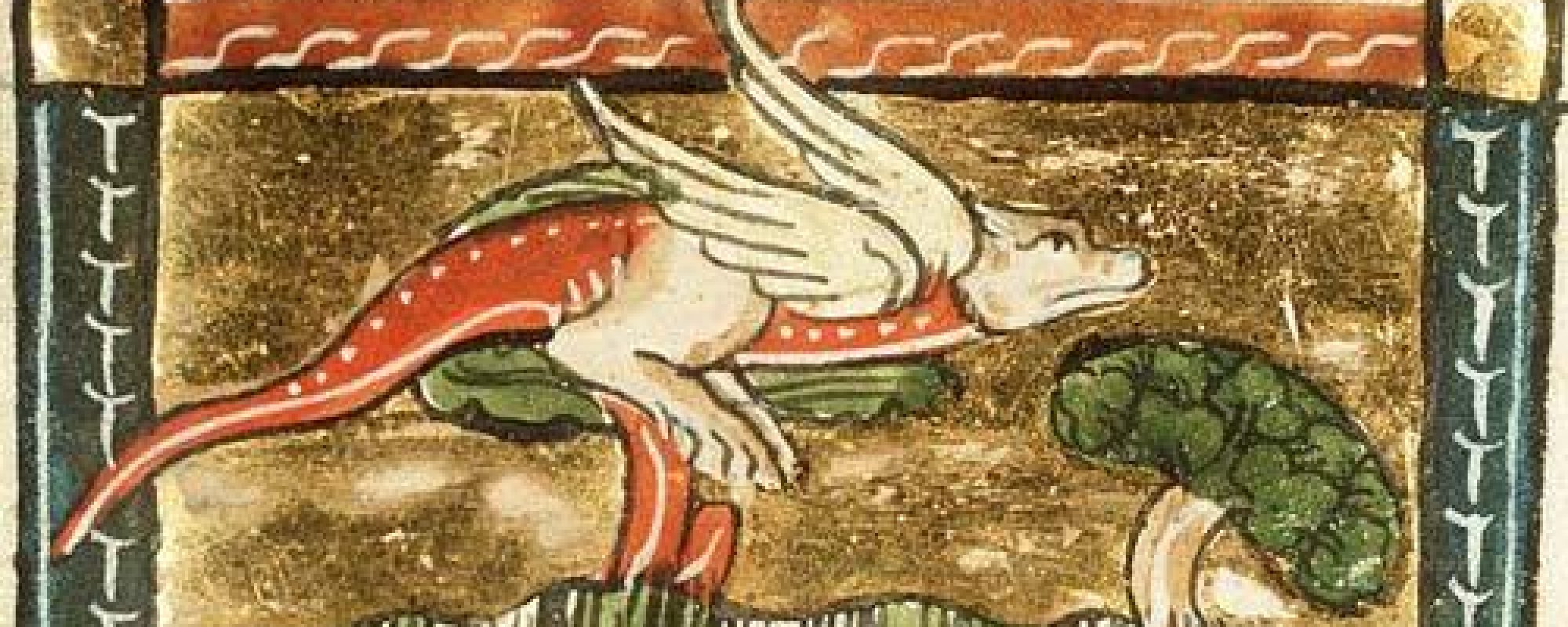By: Isabella Alday
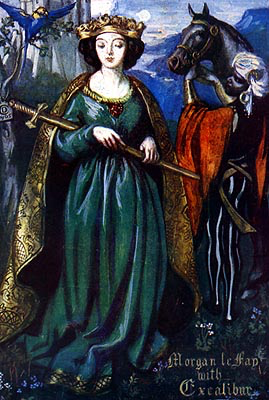
Introduction
Throughout our studies as a class, there have been many things that have intrigued me. The roles of women in both olden and modern fantasy, the complex and binding rules of chivalry, the revelation that chivalry derives from a code of ethics regarding how a knight should take care of his horse, and so much more. I was particularly intrigued by the magical characters that would appear in our readings. Such as, the spirits that taunted and tested the knights in Malory’s Morte Darthur and the Fairy Mistress in Marie de France’s Lanval. But, the magical character that intrigued me the most was Morgan le Fay from Sir Gawain and the Green Knight by the Gawain Poet.
In Sir Gawain and the Green Knight, a knight that is completely green comes to Arthur’s court and mocks the court’s supposed bravery by challenging them to a beheading game. Sir Gawain accepts the challenge on King Arthur’s behalf and beheads the Green Knight who is left unaffected. Exactly a year later, Gawain has to find the Green Knight and let him behead him. Gawain waits until the very last moment to find the Green Knight and instead spends a great amount of time at the castle of Bertilak. There, he engages in a game with Bertilak where they have to exchange whatever the other received during the day. Bertilak gives Gawain prizes from his hunts and Gawain gives Bertilak kisses he received from Bertilak’s wife. Eventually, Gawain goes to the Green Knight who swings at him and knicks him but does not behead him. The Green Knight reveals himself to be Bertilak and tells Gawain that the entire thing was a trick set up by Morgan le Fay in hopes that the first beheading at King Arthur’s court would frighten Queen Guinevere to death. Morgan’s reveal in Sir Gawain and the Green Knight and her motives completely shocked me, so I wanted to do more research on her.
The origins of Morgan Le fay
Morgan le Fay, meaning “Morgan the Fairy,” is a powerful sorceress and the half-sister of King Arthur. She is sometimes depicted as the rule of Avalon and said to have a number of magical powers including shape-shifting, flying, and causing hallucinations over bodies of water (“Fata Morgana”).
There are many different theories to the origin of Morgan. Some scholars associate her Morrígan, the Irish goddess of war, or Modron, a Welsh goddess (Dalecky 3). The Morrígan originated from the “megalithic cult of mothers” who typically appeared as “triple goddesses” and used magic and trickery to influence warfare (Murphy). This is similar to Morgan le Fay’s use of magic to ruin Arthur’s battle with Sir Accolon by stealing Excalibur (“Morgan Le Fay”). Like the mothers, the Morrígan could appear as a beautiful woman or a crow which mirrors Morgan’s ability to shape-shift (Murphy). Modron is a mother goddess whose father is Afallach, king of the Otherworld Avalon (“Modron”). This connection to Avalon is one of the reasons scholars believe Morgan le Fay is based on Modron.
Morgan le Fay is first introduced in Arthurian literature in Geoffrey of Monmouth’s Vita Merlini as “Morgen” (Rise). She is described as the first of nine sisters who rule “The Fortunate Island” or “The Isle of Apples”, also known as Avalon (Dalecky 12). She is “a doctor in the art of healing and exceeds her sisters in excellent form” (12). As well as healing, she can shape-shift and fly (12). Arthur is brought to her after being wounded in battle and she says she can heal Arthur if he stays with her for an extended period of time (12). The next important mention of Morgan in Arthurian literature is in Thomas Malory’s Le Morte d’Arthur. Malory adds the surname “le Fay” (Dalecky). In Le Morte d’Arthur, Morgan is Arthur’s half-sister, the daughter of Arthur’s mother Ygerna (or Igraine), and her first husband, Gorlois. She is depicted as Arthur’s rival, jealous of his power, and determined to steal the throne from him (“Morgan Le Fay”). Monmouth and Malory are both great influencers of Arthurian legend and their depictions of Morgan le Fay more than likely set the standards for the different ways she was depicted in Arthurian literature.
Morgan the Evil Sorceress
The lady’s wicked character appears to have been the invention of the Cistercian monks who wrote the stories of the Vulgate Cycle. Influenced by memories of the ancient Irish Goddess, the Morrighan (Phantom Queen), another triple-aspect divinity representing life & death, sexuality and conflict, they painted poor pagan Morgan as black as they could. They believed it blasphemous for a healer to be neither male nor a member of a religious order and Morgan paid dearly for her reputation.
“Morgan Le Fay, Queen of ‘Gore’.” EBK: Queen Morgan Le Fay of North Rheged, Nash Ford Publishing, http://www.earlybritishkingdoms.com/bios/morgan.html.
The Vulgate Cycle, also known as the “Lancelot-Graal” cycle, was a major influential piece of work on the legends of King Arthur from the 13th century (Joe). The Vulgate Cycle was originally compromised of “Lancelot Proper (or ‘Lancelot’), the Queste del Saint Graal (‘Quest of the Holy Grail’), and the La Mort le Roi Artu (‘Mort Artu’ or ‘Death of King Arthur’).” L’Estoire du Graal (“History of the Holy Grail”) and the Prose Merlin were added to the other core stories. It took the legends written by Geoffrey of Monmouth and Wace and elaborated on them. It added new adventures and new characters or changed them dramatically. The Vulgate Cycles influenced Malory’s Le Morte d’Arthur (Joe).
Malory’s depiction of Morgan le Fay was a great shift from Monmouth’s. In Le More d’Arthur, Morgan is referred to as Morgan le Fay as opposed to “Morgen” and she is Arthur’s half-sister instead of a ruler of Avalon that Arthur meets. She is sent to a nunnery where she learns “necromancy” and after is wedded to King Uriens and bears his son, Sir Uwaine (Dalecky). Malory has Morgan betray Arthur’s trust by stealing Excalibur and giving it to her lover Sir Accolon in hopes of killing Arthur. When this plan fails, she throws Excalibur’s scabbard into a lake robbing Arthur of the protection the scabbard provided him (“Morgan le Fay”). This is the complete opposite of the intelligent healer that offers to care for Arthur in Monmouth’s Vita Merlini.
This negative depiction of Morgan is likely due to Malory being influenced by the Vulgate cycle. It is theorized that the monks who wrote the Vulgate Cycle could not reconcile the idea of a woman who was powerful, magical, sexually liberated, and good (“Morgan Le Fay: Queen of Gore”). In Celtic rule, women had “equal if not greater power than men and were expected to take lovers” (Rise). But this does not translate to the Christian views of morality, so Morgan le Fay became evil.
This is the image that is now most common for Morgan le Fay. The details vary but the image stays the same. Sometimes she is Merlin’s lover, sometimes she tricks Arthur into sleeping with her, or sometimes she has a lover despite being married, but she is principally sexually promiscuous. Sometimes she learned magic in a nunnery, sometimes Merlin offers to teach her magic, sometimes she tricks Merlin into teaching her magic, but she is always powerful with magic. These traits are then used to paint her as a manipulative and powerful temptress.
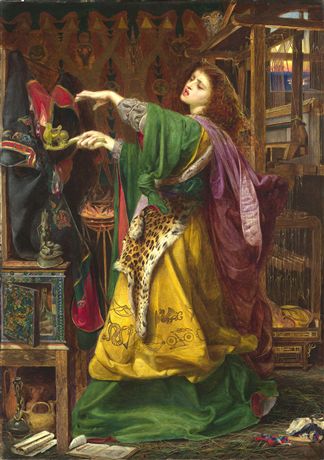
Sandys met the model for Morgan-Le-Fay, Keomi, in a gypsy camp in Rome. Very little is known about her but she is believed to to have had an affair with the artist.”
“Birmingham Museums & Art Gallery Pre-Raphaelite Online Resource : The Collection.” News, Birmingham Museums and Art Gallery, http://www.preraphaelites.org/the-collection/1925p104/morgan-le-fay/.
Morgan Today
Morgan le Fay has continued to appear in modern culture. Marvel and DC comics both have a character based around her. In the Marvel Universe, Morgan is an antagonist for Marvel superheroes such Iron Man and Thor. She is described as a “half-faerie, an ancient magical race originating from Otherworld who access Earth via Britain and Ireland.” In the comics, her parents’ names are Gorlois and Igraine and it is believed that one of them was part-faerie. She was raised in a nunnery and Merlin trained her in sorcery in exchange for her promising to become his lover, though she does not keep this promise. Morgan is still portrayed as promiscuous and as hating King Arthur. However, she hates him because he is the result of her mother’s affair with Uther and because he favors Christianity over her own “Celtic-goddess worship.” Marvel mirrors Malory’s version of Morgan le Fay recounting the tale of her theft of Excalibur and its scabbard and throwing the scabbard in a lake, her trying to seduce Lancelot, her exposing Lancelot and Guinevere’s affair, and her constantly trying to defeat Arthur with her nephew Mordred (“Morgan Le Fay Powers, Enemies, History: Marvel”).
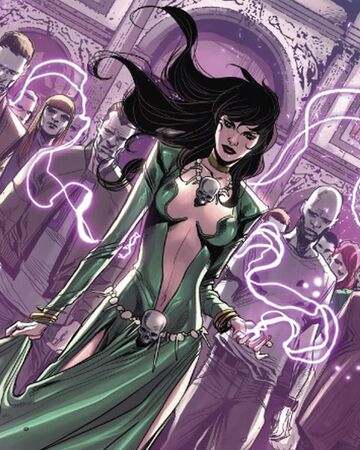
“Morgan Le Fay Powers, Enemies, History: Marvel.” Marvel Entertainment, MARVEL, http://www.marvel.com/characters/morgan-le-fay.
In the DC comics, Morgaine le Fey is an antagonist for DC heroes such as the All-Star Squadron and the Justice League. She is the daughter of the Lady of the Lake and she is heartbroken when she falls in love with Uther Pendragon but he does not love her back. She “taps the resurgence of Magic” when King Arthur is given Excalibur. As opposed to the Marvel comics, she becomes Merlin’s apprentice and then does become his lover, though she swears revenge against him after he rejects her because of her overwhelming desire for power. Similar to some portrayals of Morgan le Fay, Morgaine bewitches Arthur and gives birth to their son, Mordred, and together they attack Camelot (“Morgaine Le Fay”).
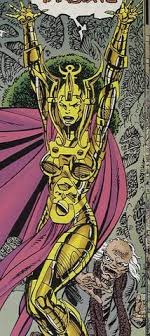
“Morgaine Le Fey (DC Comics).” Wikipedia, Wikimedia Foundation, 1 May 2020, en.wikipedia.org/wiki/Morgaine_le_Fey_(DC_Comics).
Another modern depiction of Morgan le Fay can be found in the BBC’s television show Merlin. Morgana Pendragon is the main atangonist for Merlin and King Arthur. Morgana is an orphan that Uther took care of and “treated as one of his own” (“Merlin – Morgana”). She believed her father was Gorlois but it is later revealed she is actually Uther’s daughter and Arthur’s half-sister. She starts out the show as being kind and friends with Merlin, Arthur, and her maidservant Gwen, but she later discovers she has powers such as prophecy (similar to the Morrígan’s association with fate). This scares her because Uther hates magic and executes those who used it. In Merlin, Mordred is a “young Druid boy” she instantly bonds with. Also, in the show, Morgana’s half-sister Morgause and her growing disdain for Uther are responsible for her turn to evil (“Morgana Pendragon”).
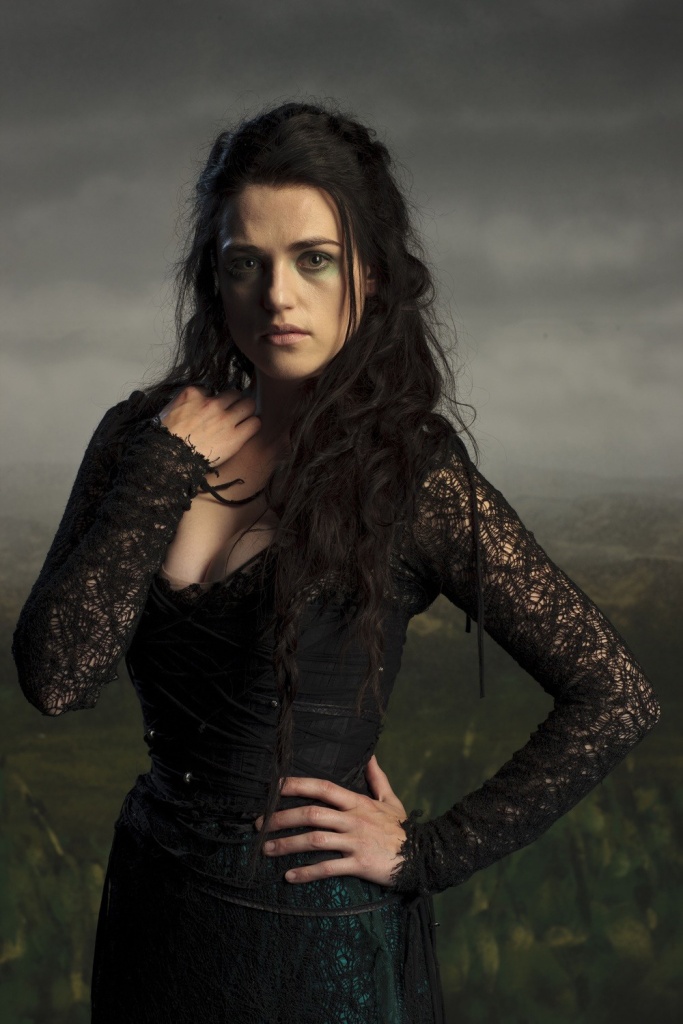
“Morgana Pendragon.” Villains Wiki, villains.fandom.com/wiki/Morgana_Pendragon.
COnclusion
Morgan le Fay is simply another woman character who was trapped by the rigidity of Medieval literature. In medieval literature, a woman has two choices to be an evil temptress or to be a pure noblewoman. It was impossible for Morgan le Fay to wield magic or even to be powerful without being evil, so she was made to be an evil sorceress. This image was carried into modern culture, though there are a few retellings that do not depict Morgan as such. However, whether she is a powerful healer or a powerful sorceress, she is always depicted as incredibly powerful, and that is empowering to see.
Works Cited
“Birmingham Museums & Art Gallery Pre-Raphaelite Online Resource : The Collection.” News, Birmingham Museums and Art Gallery, http://www.preraphaelites.org/the-collection/1925p104/morgan-le-fay/.
Dalecky, Elke. “Different Phases/Faces of Morgan Le Fay: The Changing Image of the Sorceress in Arthurian Literature.” Othes.univie, Universität Wlen, 24 Sept. 2008, othes.univie.ac.at/1206/1/2008-09-24_9760190.pdf.
“Fata Morgana.” Merriam-Webster, Merriam-Webster, http://www.merriamwebster.com/dictionary/fata%20morgana.
Lai, Kenny. “Queen Morgan Le Fay.” Morgan Le Fay, csis.pace.edu/grendel/projs993a/arthurian/morgan2.htm.
Joe, Jimmy. “An Explanation Of The Vulgate Cycle.” Timeless Myths, Timeless Myths, http://www.timelessmyths.com/arthurian/vulgate.html.
“Merlin – Morgana.” BBC One, BBC, http://www.bbc.co.uk/programmes/profiles/5SF9K5c79g3L6dtDlbGKdLV/morgana.
“Modron.” Jones Celtic Encyclopedia , Mary Jones, 2007, http://www.ancienttexts.org/library/celtic/jce/modron.html.
“Morgaine Le Fay.” DC Continuity Project, dccontinuityproject.weebly.com/morgaine-le-fay.html.
“Morgaine Le Fey (DC Comics).” Wikipedia, Wikimedia Foundation, 1 May 2020, en.wikipedia.org/wiki/Morgaine_le_Fey_(DC_Comics).
“Morgan Le Fay Powers, Enemies, History: Marvel.” Marvel Entertainment, MARVEL, http://www.marvel.com/characters/morgan-le-fay.
“Morgan Le Fay, Queen of ‘Gore’.” EBK: Queen Morgan Le Fay of North Rheged, Nash Ford Publishing, http://www.earlybritishkingdoms.com/bios/morgan.html.
“Morgan Le Fay.” King Arthur’s Knights, King Arthur’s Knights, kingarthursknights.com/arthurian-characters/morgan-le-fay/.
“Morgana Pendragon.” Villains Wiki, villains.fandom.com/wiki/Morgana_Pendragon.
Murphy, Anthony. “Mythical Ireland: Myths & Legends: The Morrígan.” Mythical Ireland | New Light on the Ancient Past, Mythical Ireland & Anthony Murphy, 16 Jan. 2018, http://www.mythicalireland.com/myths-and-legends/the-morrigan/.
Rise, Brian E. “Morgan Le Fay.” Morgan Le Fay | Encyclopedia Mythica, MCMXCV-MMXIX Encyclopedia Mythica, 30 Mar. 1999, pantheon.org/articles/m/morgan_le_fay.html.
